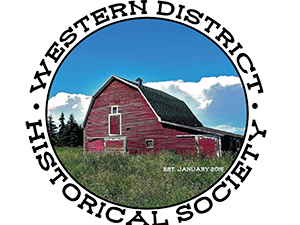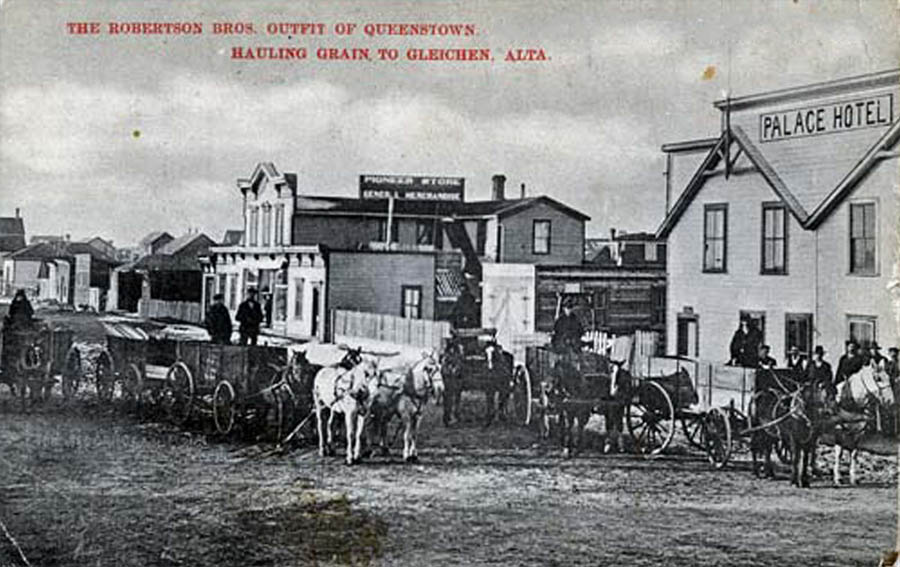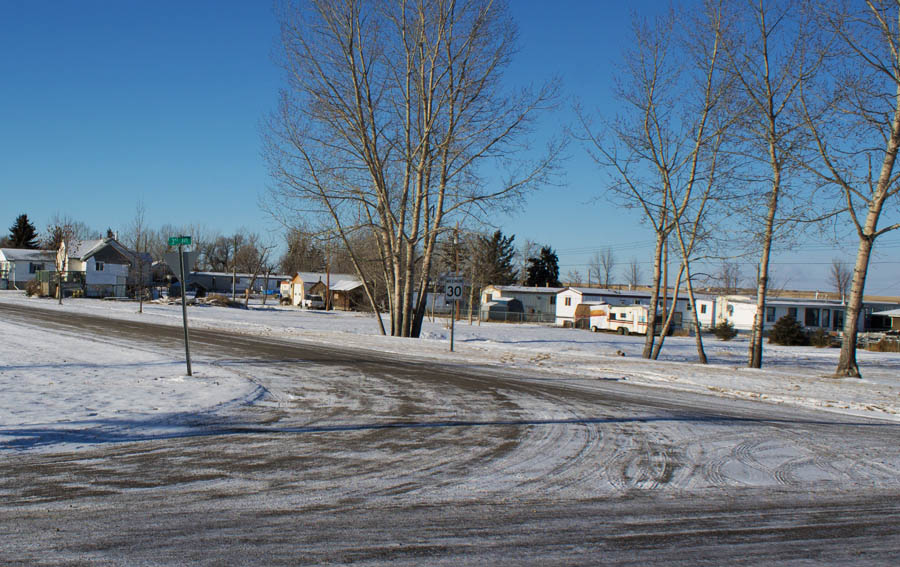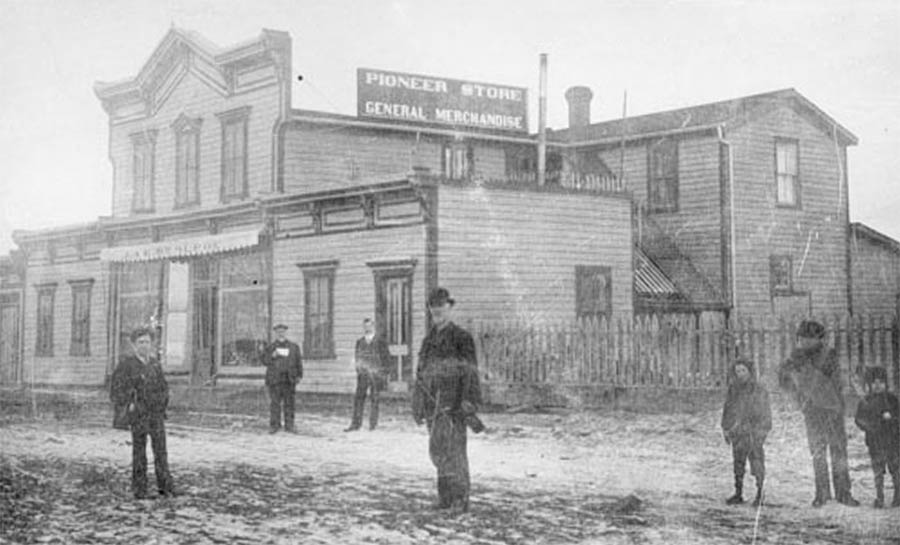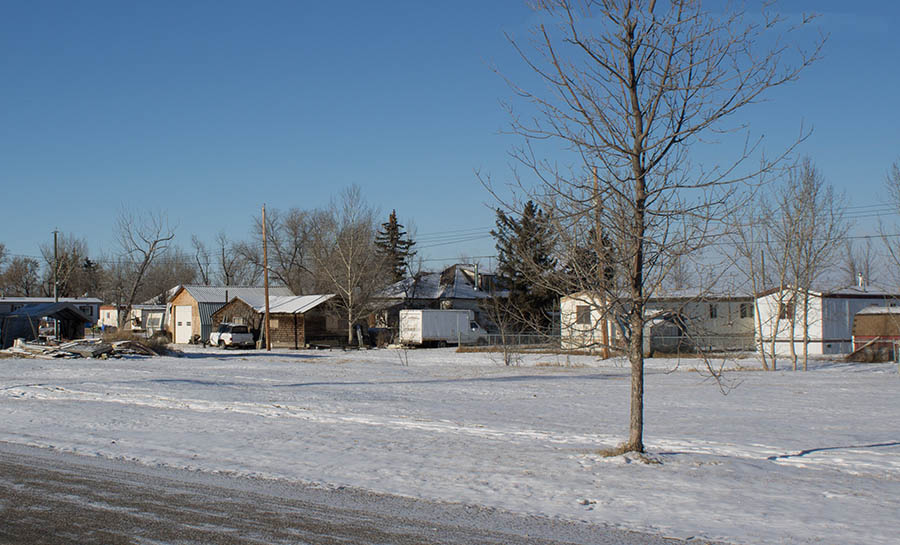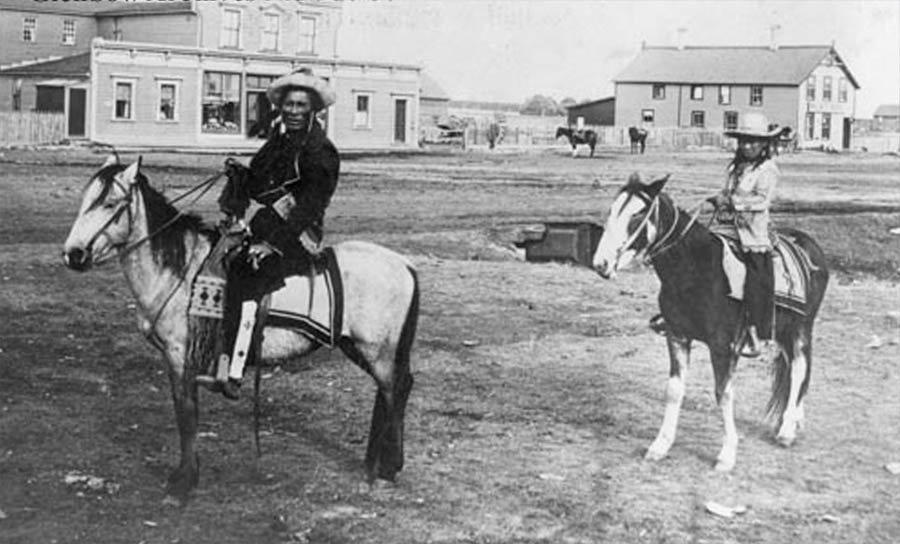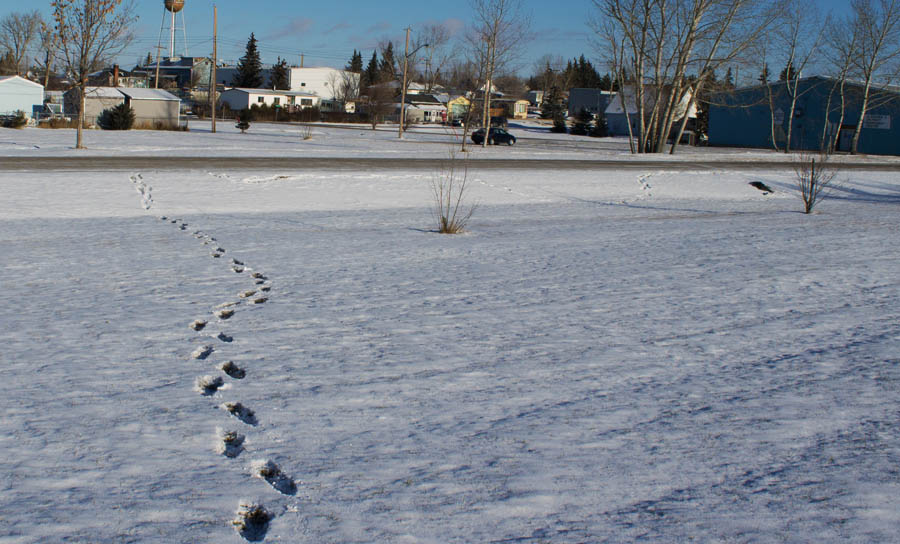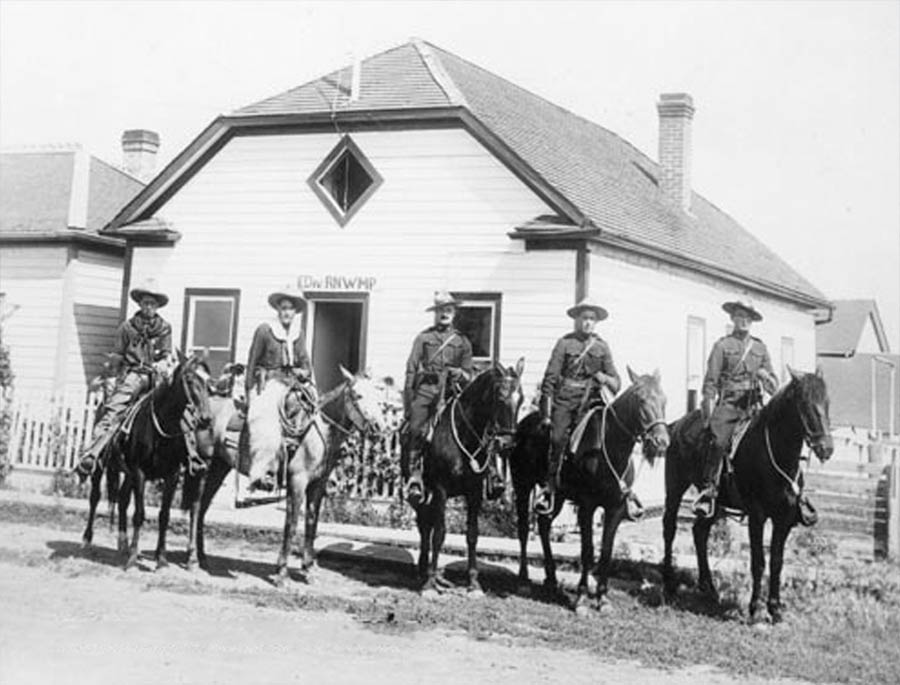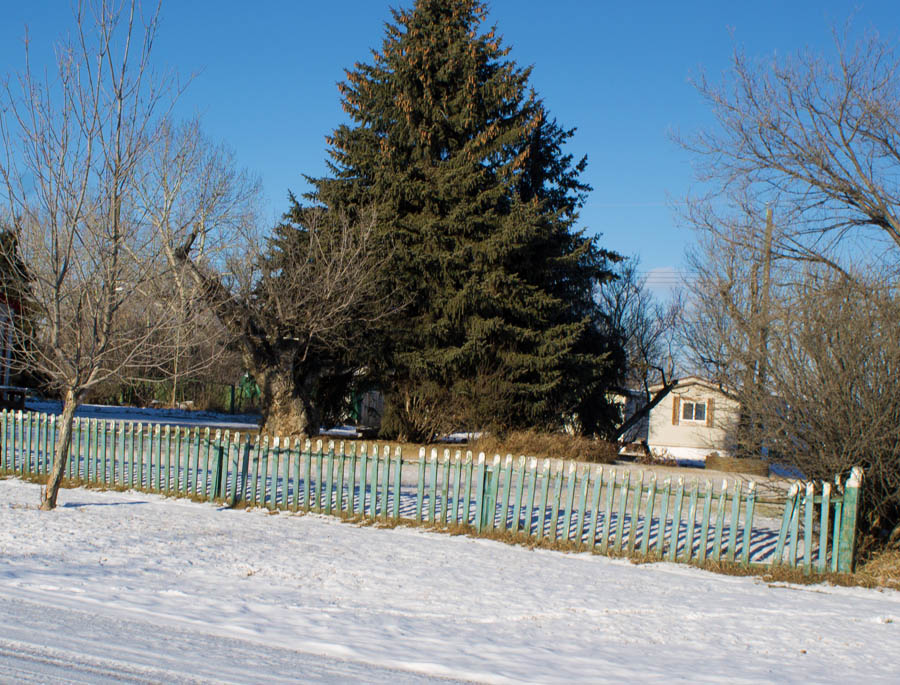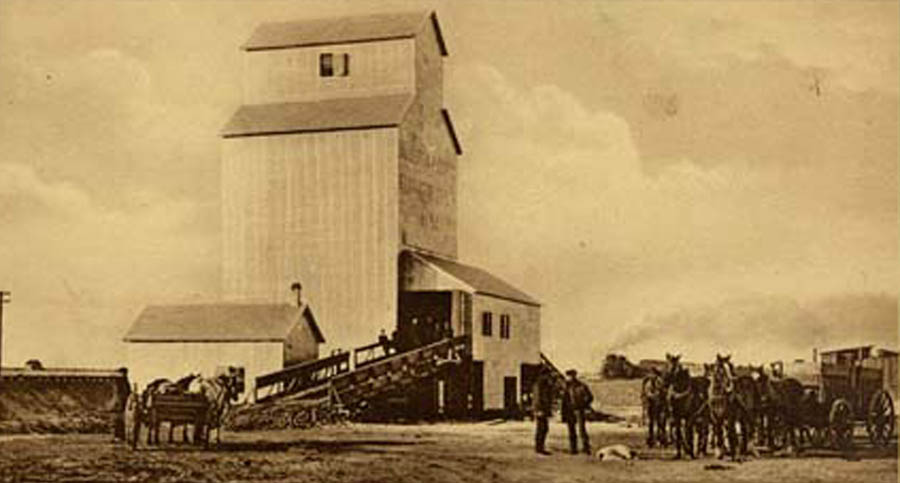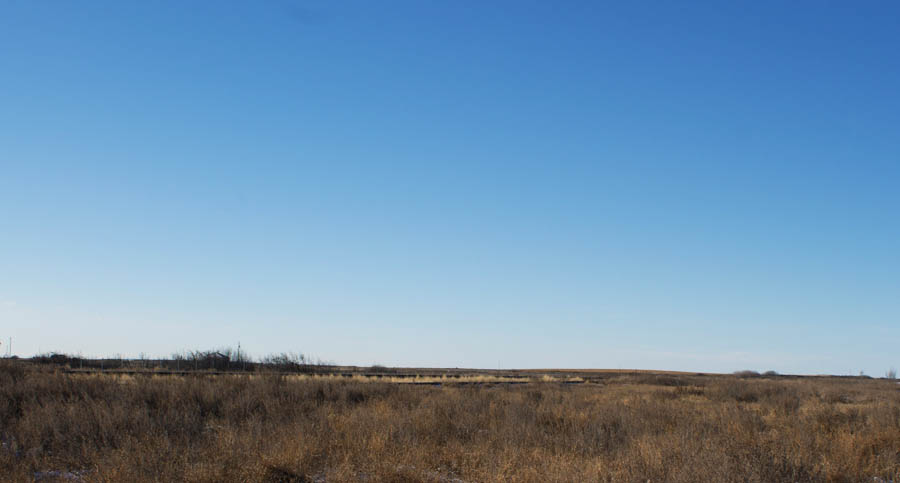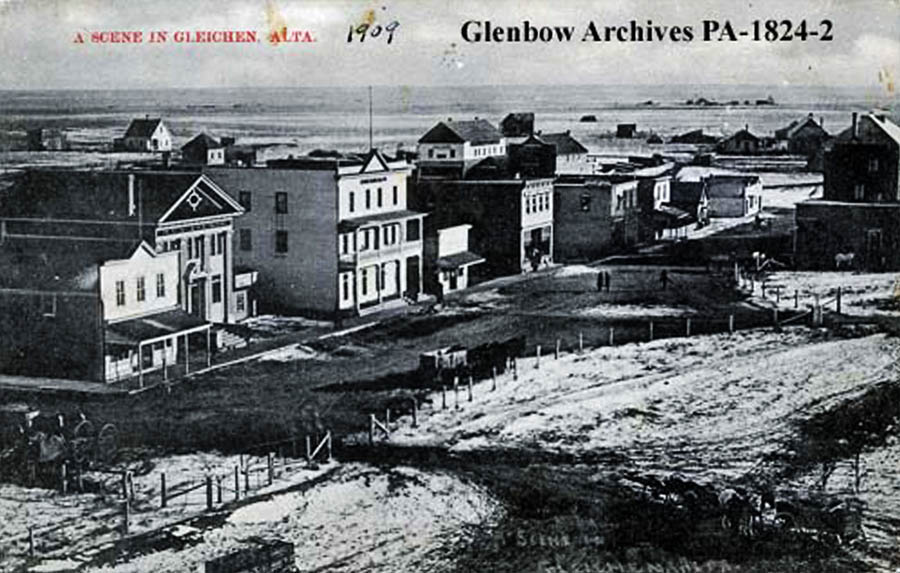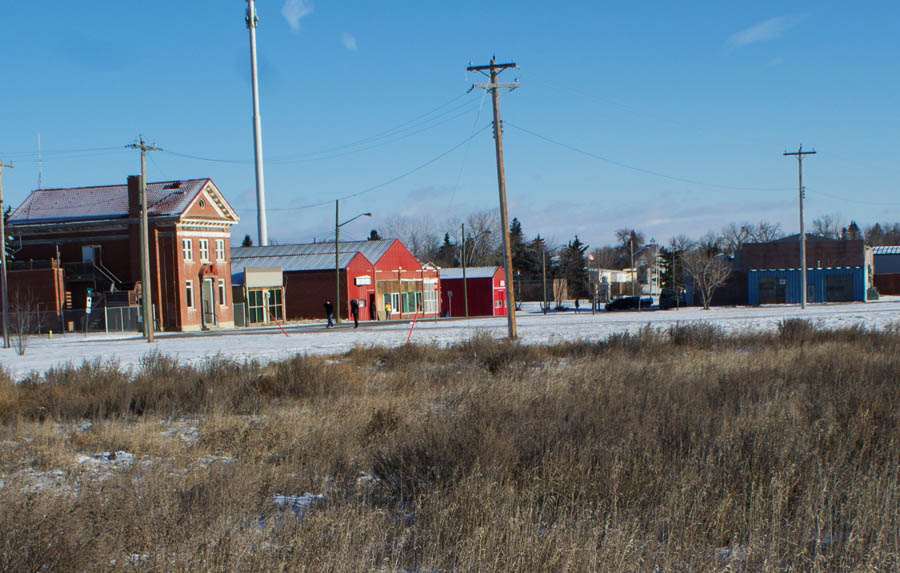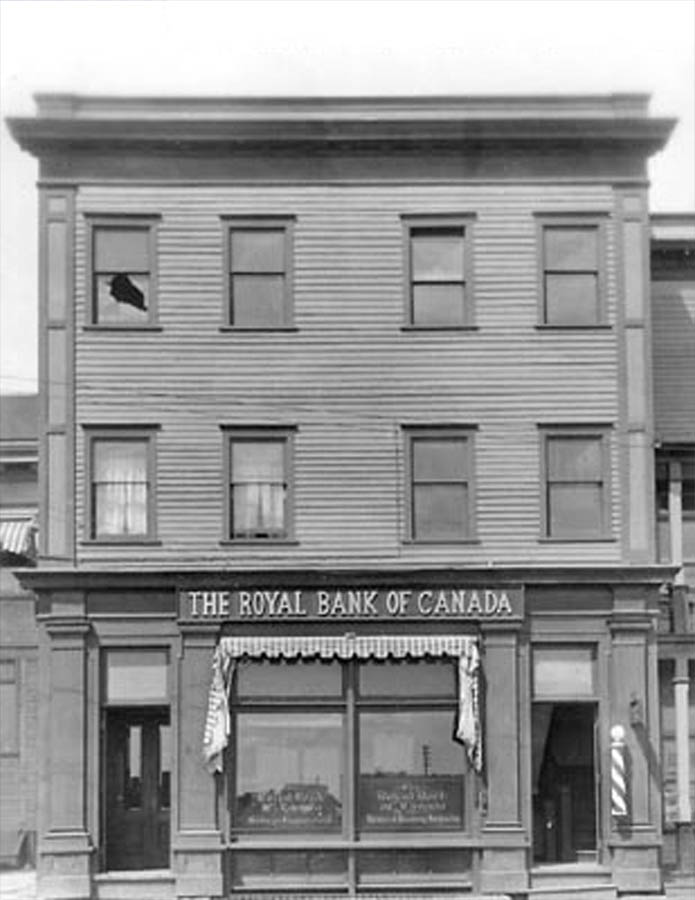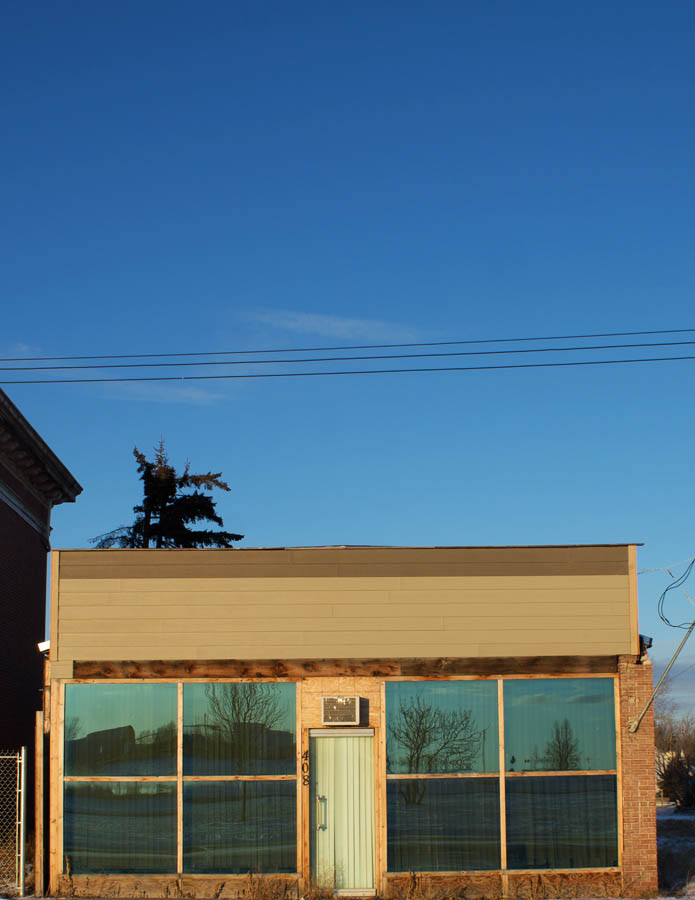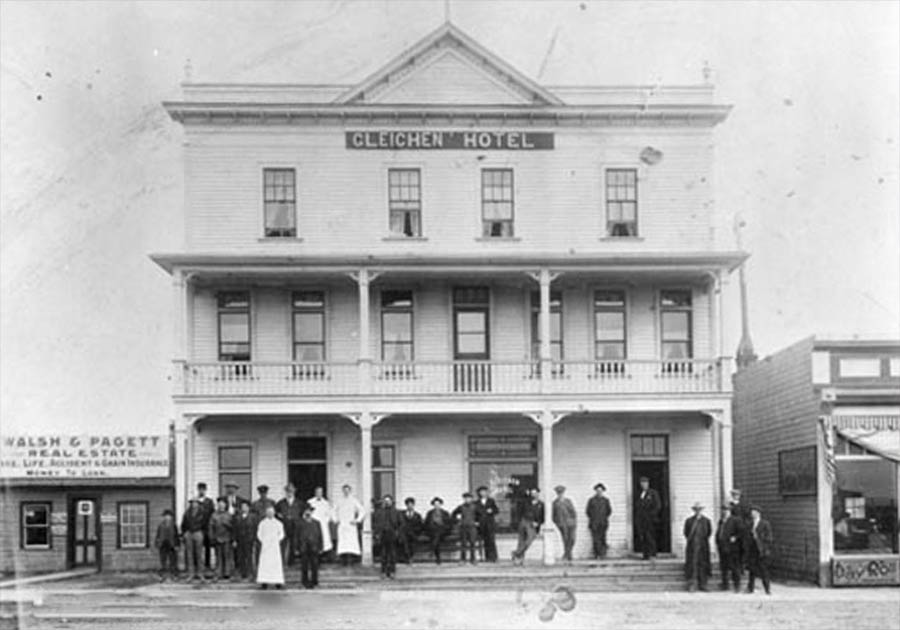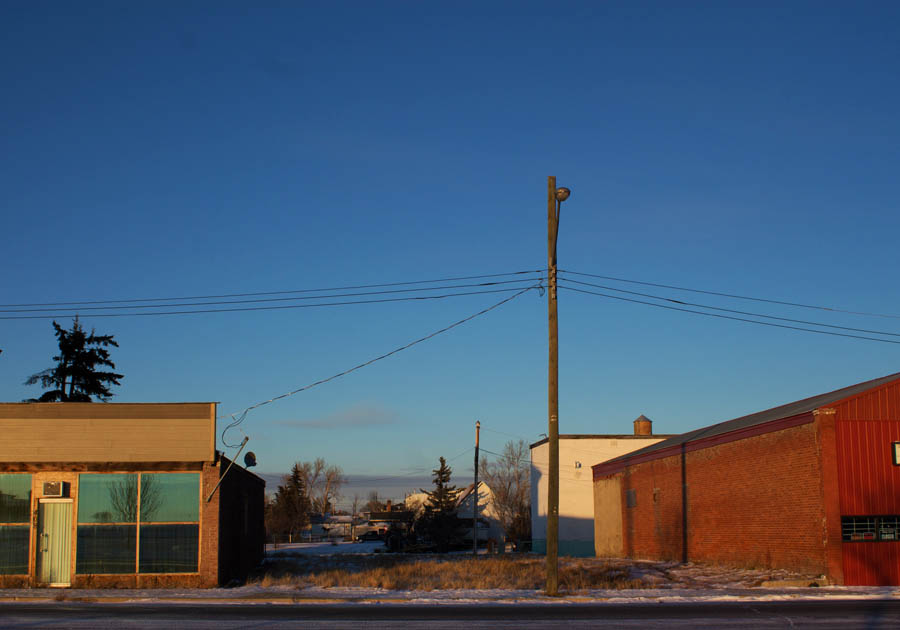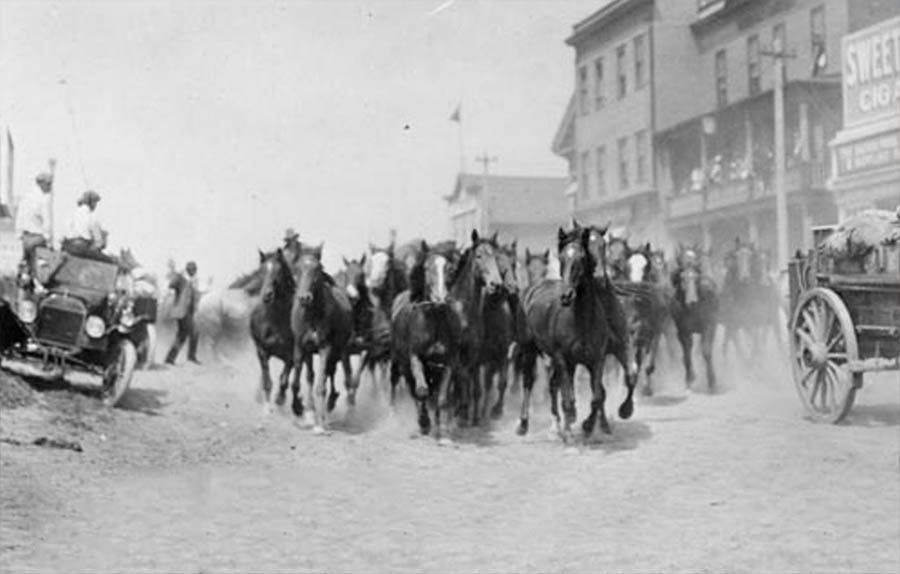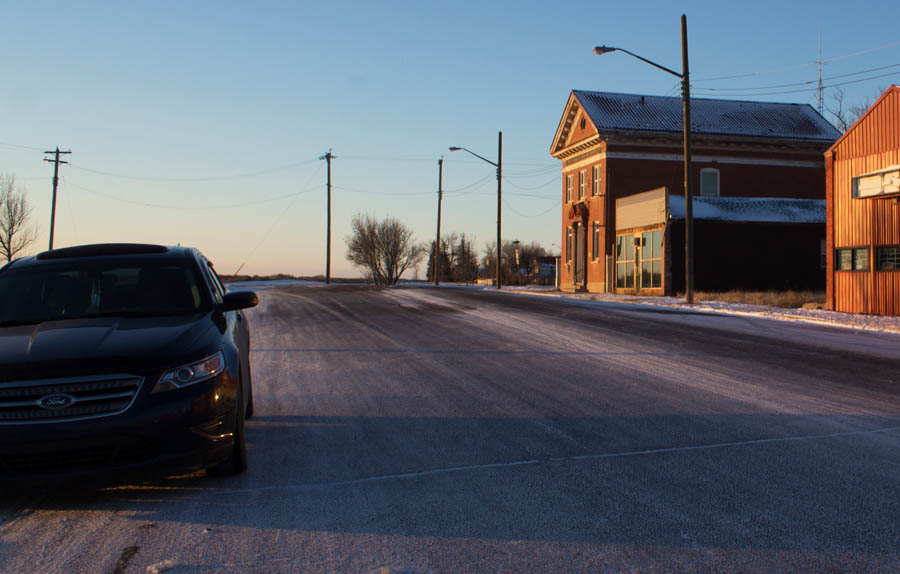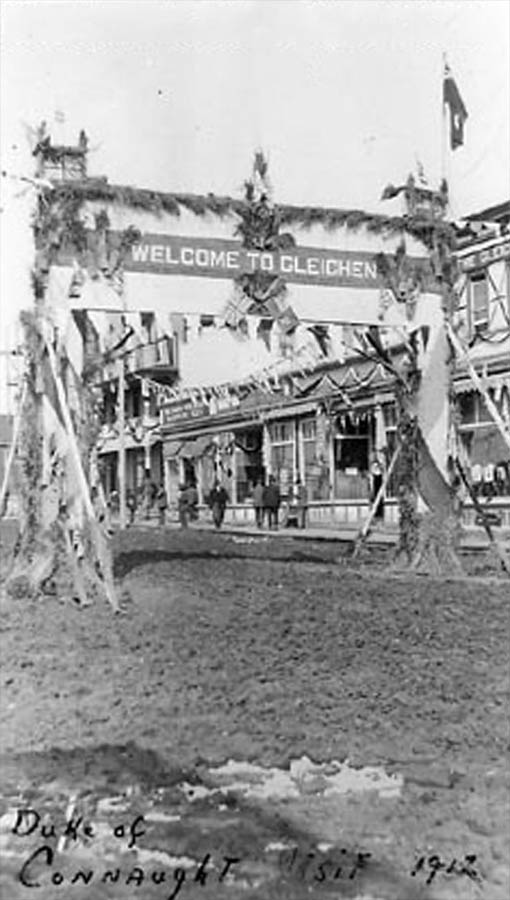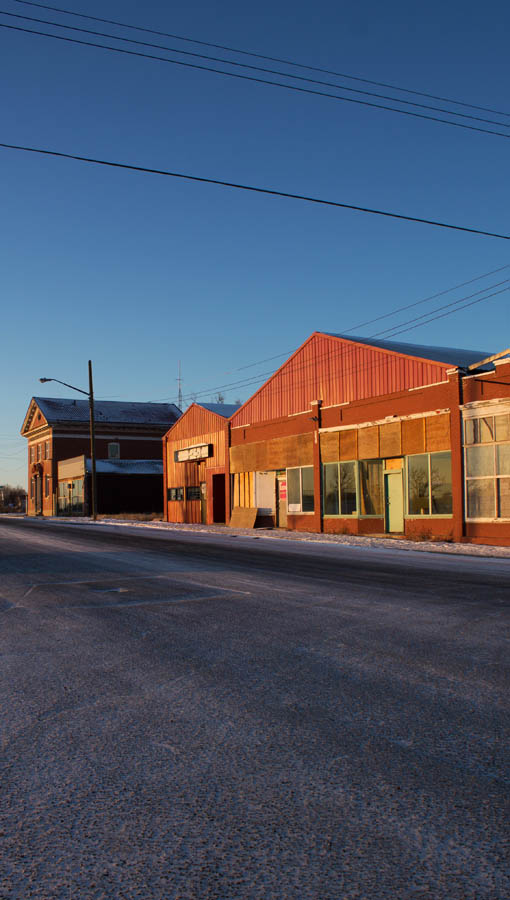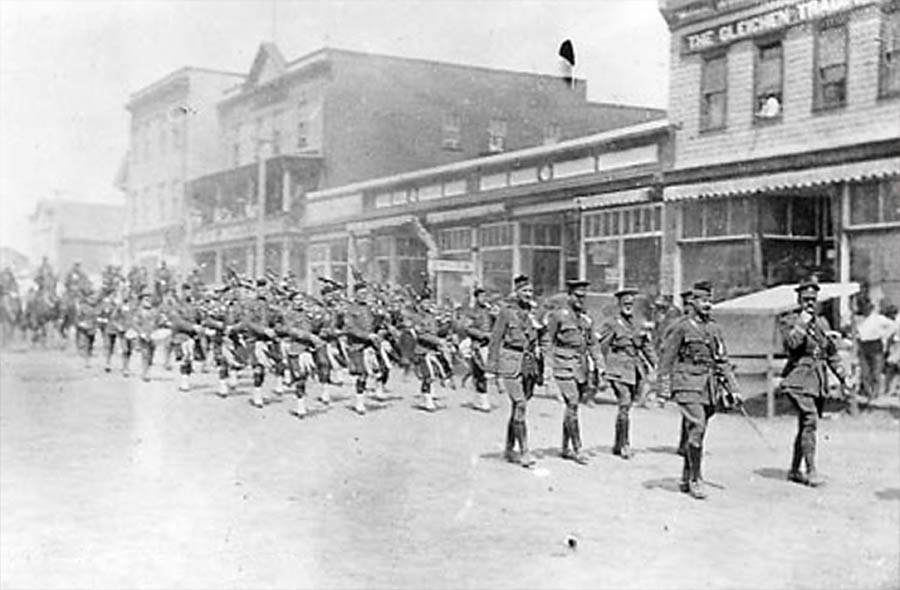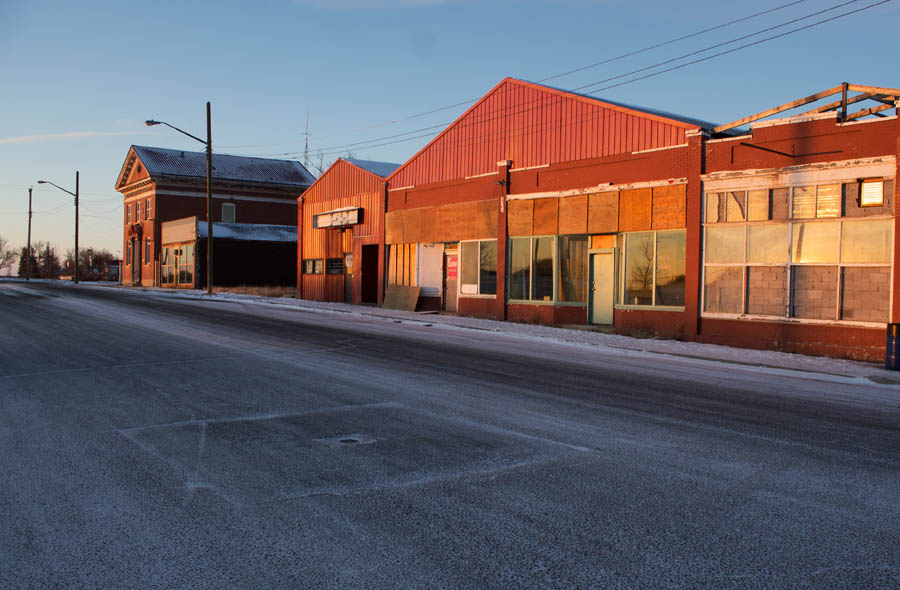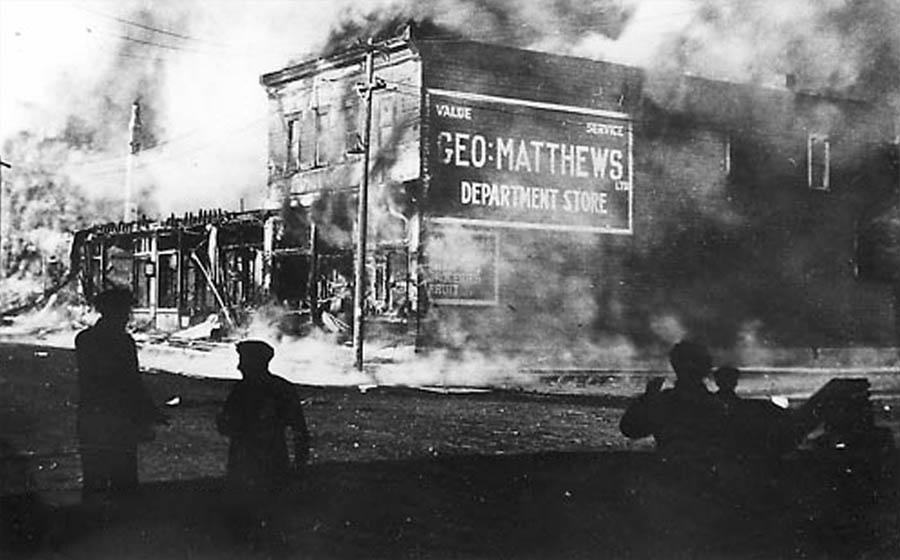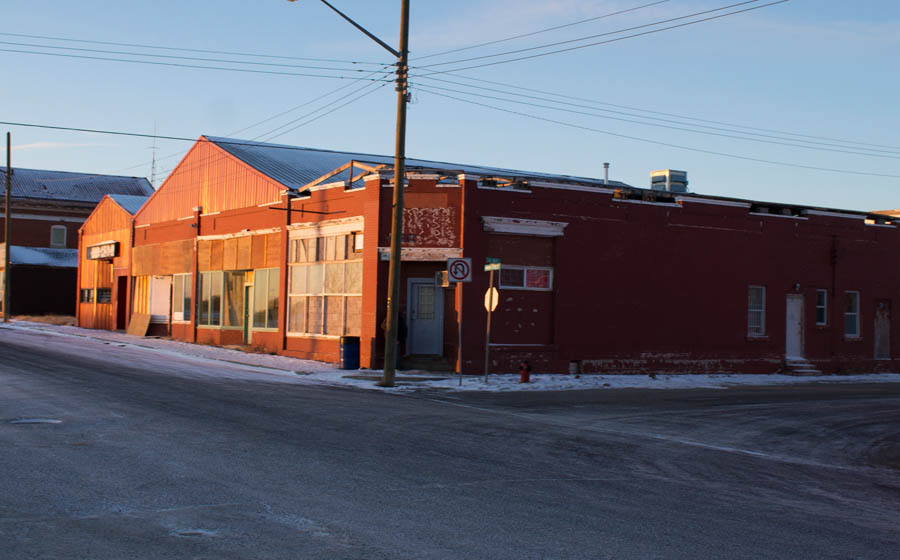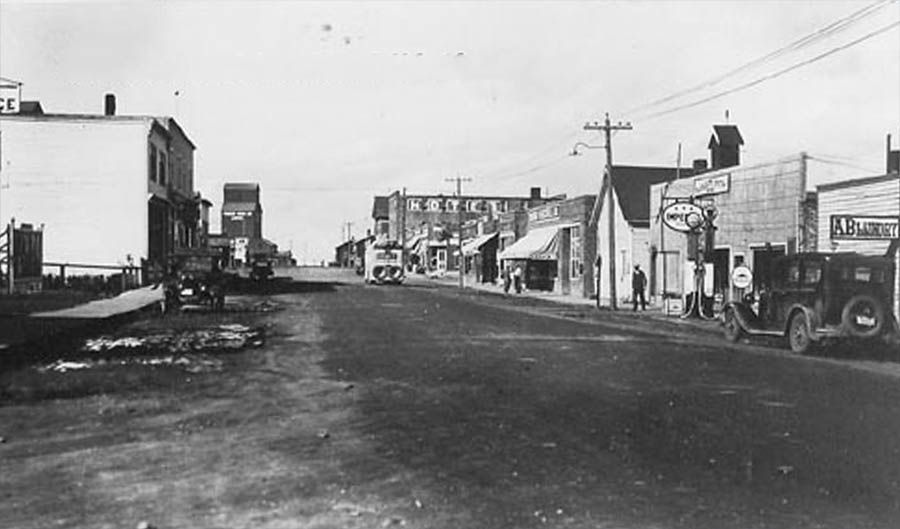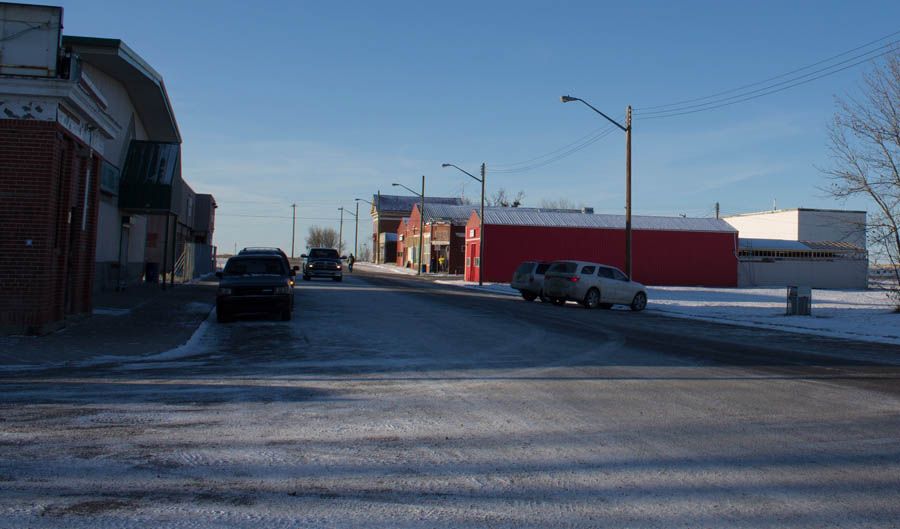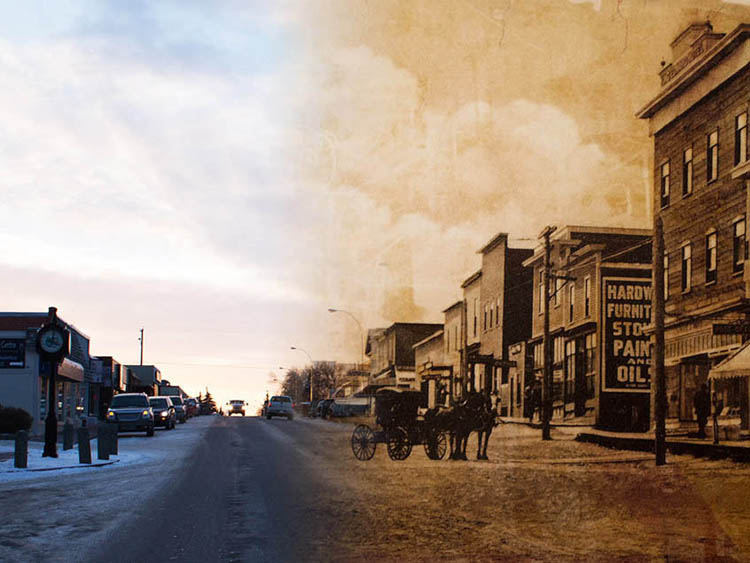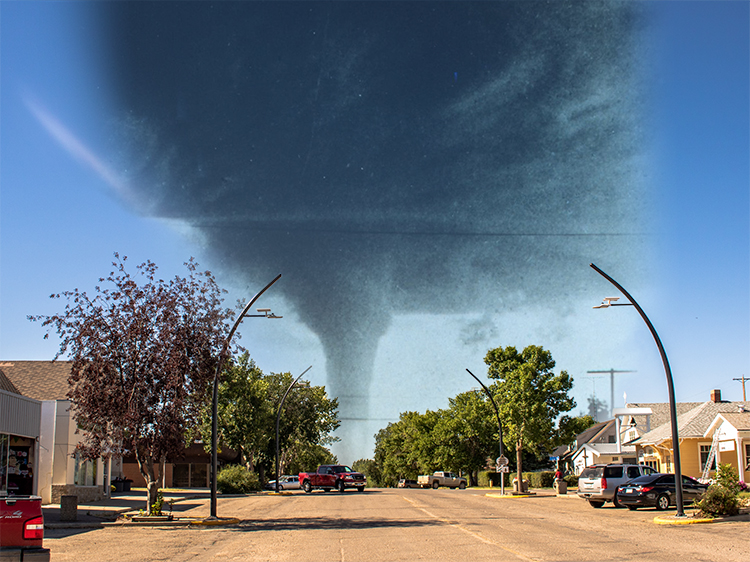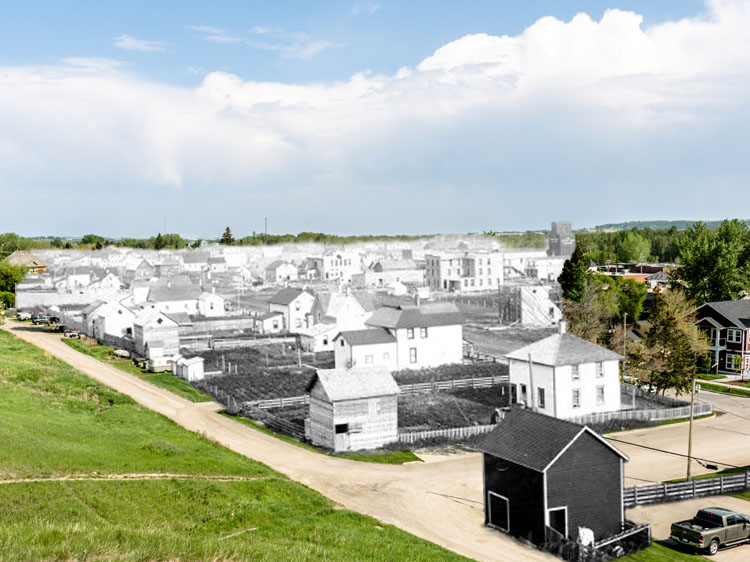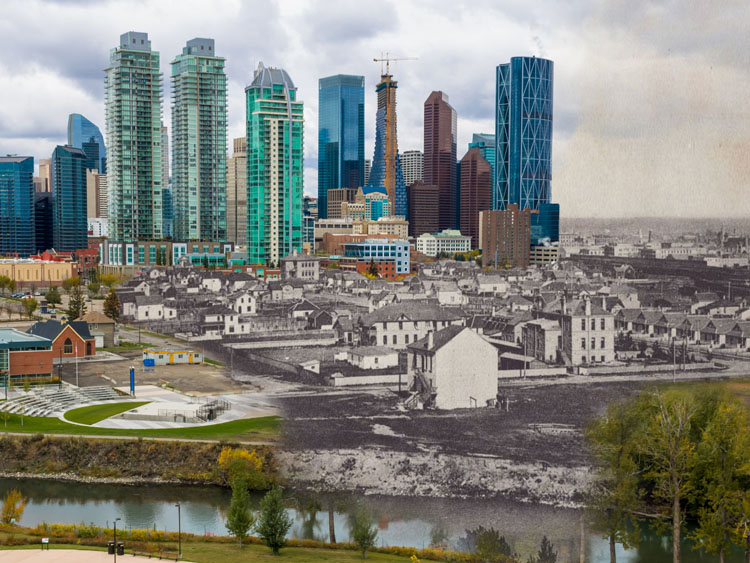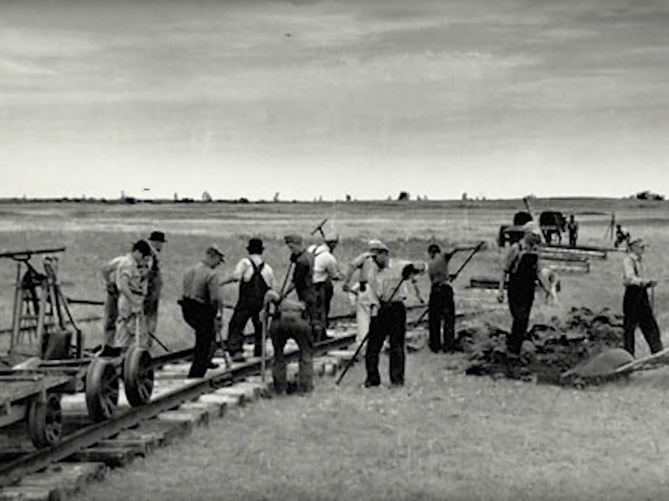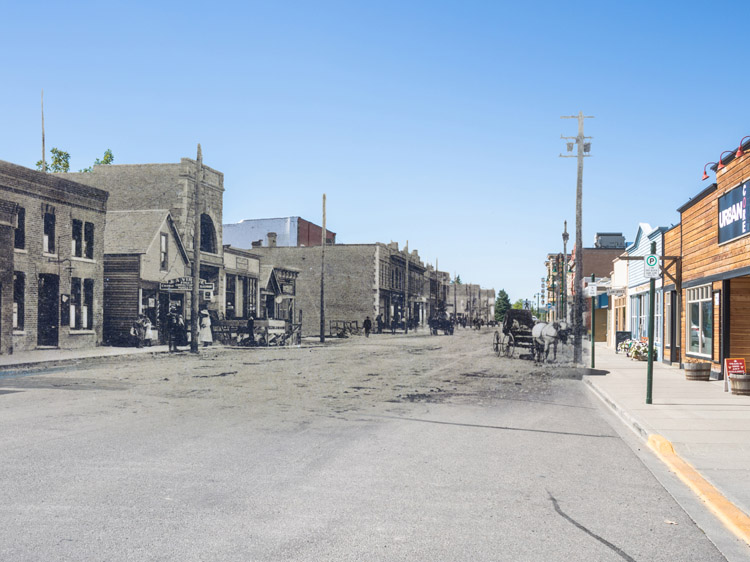Walking Tour
The Story of Gleichen
Gleichen's Boomtown Era
Andrew Farris
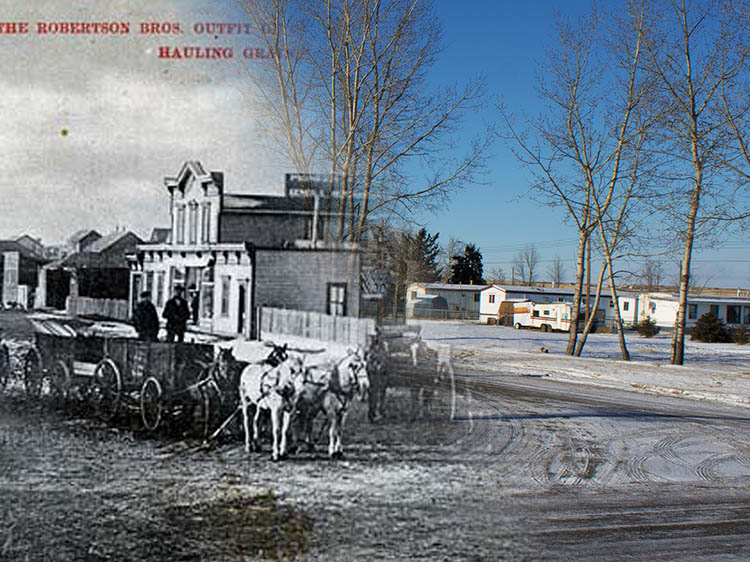
Glenbow Museum and Archives PA-1824-1
For a brief period in the early 20th Century Gleichen was a busy railway town of over 2,000 people that had big city dreams. Looking around today it's obvious those dreams haven't been realized: Today the population is less than a fifth of what it once was. What happened? In this tour we'll examine Gleichen boomtown history, how it grew from a hub of ranching activity and home of the Blackfoot reserve in the late 1800s, to a major farming community. Then we'll see how the successive blows of world war, drought, economic depression and technological change caused people to float away to greener pastures. Yet unlike many railway towns Gleichen did not die, and today the population is slowly picking up again, while a devoted community is working to preserve the parts of the town's boomtown history that survive to this day.
This project is only possible with the generous sponsorship and support of the Western District Historical Society. We also owe thanks to the Hamlet of Gleichen, the Strathmore Travelodge, and members of the Western District Historical Society.
1. What Was Once Here
1908
Here we see the Robertson Brothers hauling grain into Gleichen. This photo is a window into another world. Today there is little evidence of the Robertson Brothers here, to say nothing of the Palace Hotel or Beaupre's general store that once stood on Railway Street. Hard as it may be to believe, over 100 years ago this street was a bustling thoroughfare for a rapidly growing little town. Since then much has changed.
* * *
Nevertheless many homes and businesses have not survived and are now simply empty plots of land.
2. The Railway Arrives
1900
Men and children stand outside the Pioneer Store that once stood here. It's interesting to see how they all seem to have all immediately dropped what they were doing to pose for the photographer. They were part of a great flood of people who came to Gleichen after the arrival of the railway in 1883.
* * *
Some missionaries had arrived to minister to the Blackfoot and had set up shop here. As such the surveyors of the Canadian Pacific Railway ran the railway through this place and in the summer of 1883 the construction teams laid the tracks here at a blistering pace. Stops, or sidings, where trains could be refuelled and parked on a secondary track, were built at regular intervals and the siding that would become Gleichen was the 12th siding west of Medicine Hat. In those early days the place was called "Twelfth Siding".
Such a name would not do, and soon after the name Gleichen was chosen, named for a 20-year-old financier of the CPR, Count Albert Edward Wilfred Gleichen. His father, a member of the German aristocracy, had moved to England and risen to the rank of admiral in the Royal Navy. His son evidently invested some of the family fortune in Canada and he was eager to see how his money was being spent. Shortly after the railway here was completed he travelled through the town that would shortly bear his name.
Interestingly, his name was pronounced 'Glaikhen', with the 'kh' sounding like the 'ch' in 'loch'. The town's inhabitants at some point Anglicized the pronunciation to something more like 'Gleeshen'.1
3. The Blackfoot
1880s
Two Blackfoot on horseback in front of Beaupre's Pioneer Store. This store was built the same year the railway arrived and soon became a meeting place for both whites and the Blackfoot, whose reserve was just on the south side of the railway. The Blackfoot had migrated into this area 250 years before and quickly adopted European horses. Their horsemanship became legendary on these prairies.
* * *
The Blackfoot took to horses immediately. The animals allowed the Blackfoot to range across the prairies and pursue the herds of buffalo upon which their way of life depended. The horses offered such incredible mobility that they quickly became the main currency used by the Blackfoot, and throughout the 19th Century many minor wars were waged between the Blackfoot and neighbouring tribes over the possession of horses.
By the time the railway had arrived in the 1880s the Blackfoot had a great many horses, and for decades after they were frequently seen in the town competing in horse races or taking part in the Stampede.1
4. The Reserve
1890s
This is where the Royal North West Mounted Police (RNWMP) barracks once stood, and in this photo several constables are posing proudly with their horses. The RNWMP came to this place in 1874 to break up the illegal traffic of fur traders and preserve peaceful relations between the Blackfoot and the white settlers. After Treaty 7 was signed in 1877, the Blackfoot suddenly found themselves confined to a small reserve south of the railway. Their living conditions deteriorated rapidly after the arrival of the railway.
* * *
Moreover the Blackfoot's nomadic way of life, which was based on moving across the prairies following the herds of buffalo over the course of the seasons, was simply incompatible with the plans the whites had in mind for the land. Thanks to modern rifles and a disturbing lack of concern about the fate of the herds, the whites hunted the buffalo to the edge of extinction within a few short years.
Meanwhile as the prairies were being parcelled off to private landholders, it would not do to have the Blackfoot ranging around the province trespassing on suddenly private property. From white society's perspective the Blackfoot needed to be kept in a single place where they could be easily controlled and forcibly assimilated into white Canadian society. As such Treaty 7, which concerned the Blackfoot, confined them to the small reserve across the railway tracks from Gleichen.
The Blackfoot were in no position to protest. With the disappearance of the buffalo herds they were now facing starvation, and only by moving to the reserves could they receive meager supplies of food from the government. There they lived in abject poverty on the edge of starvation. One Gleichen resident remembered the scene at the building that distributed food to the Blackfoot:
When an animal was slaughtered the [Blackfoot] women and children gathered around this old ration house and the women begged for the innards - the stomach and intestines were valuable to them in those days and often they would not wait to cook them but eat the tripe or intestines raw. To a white man it was a rather terrible thing to see.2
5. Ranching Country
1910
This well-composed shot shows several teams of horses delivering grain to an elevator. In the background a train is chugging into Gleichen, leaving a long trail of smoke into the distance. The settlers came here for the region's greatest natural resource: soil. The economy depended first on ranching, and then later on intensive agriculture, and the promise of the soil, along with a planned irrigation scheme, made Gleichen's farming future look bright.
* * *
Gleichen quickly rose to prominence as a transit hub for ranchers for miles around, as well as a jumping off point for some small scale settlement schemes that did receive the railway's blessing. One such scheme was militia general Bland Strange's plan to set up a flax farming colony. Another, known as the Canadian Agricultural Coal and Colonization Company, was concocted by British capitalists to create a diversified farming colony. Neither of these schemes was particularly successful, though they brought people into Gleichen and caused it to grow much faster than any of its neighbouring towns in the 1880s and 1890s. Strathmore, for instance, was practically nothing but a name on a map until 1907.1
The ranchers dominated early Gleichen and didn't like the idea of farmers coming in and competing with them for land. The land, they said, was too dry for farming anyway. Unfortunately for them, Alberta was changing rapidly, and by 1906 the brief golden era of the rancher was drawing to a close.
6. The Farmers Take Over
1909
A photo of Gleichen in its heyday taken from the top of one of the elevators that once stood on this spot. After 1906 and the construction of the irrigation scheme, Gleichen grew much faster as farmers flooded in and supplanted the ranchers, who quickly faded into the background.
* * *
This massive undertaking meant moving 10 million cubic yards of dirt and the use of nine million board feet of lumber to build the headgates, drops, bridges and other infrastructure the irrigation system required. As the Gleichen History Book writes, "The magnitude of constructing this irrigation system is hard for the present day reader to understand. All travelling and the major portions of earth moving and hauling of all materials was achieved by the use of horse (or mule) power. No cars, trucks or tractors helped in building this system."1
As the farmers moved in the ranchers were finding themselves cut off from larger and larger areas of land to graze their gigantic cattle herds. They were also dealt a decisive blow by the cruel winter of 1906-07. Long remembered afterwards as the "hard winter", recurring blizzards and -60 Celsius temperatures decimated the herds. The ranchers desperately tried to plough the drifts of frozen snow to allow the cows to reach the grass underneath, but it made little difference. 65% of the cattle in the Gleichen area were wiped out. By the time spring came one Gleichen rancher's herd had shrunk from hundreds of cattle to just 18. To put it mildly, the winter "seemed to spoil the predictions that the grain farmers would fail because this was ranching country."2
7. The Newcomers
1910s
The well-designed Royal Bank of Canada was a sure sign the town was coming into its own. Many of the farmers who came to Gleichen often had little money and the banks were absolutely crucial to lending them money to get started and helping them get through bad harvest years.
* * *
The land around Gleichen was not free but owned by the Canadian Pacific Railway, who sold off the irrigated plots of land for a higher price than the government. Those who took up the challenge found the homesteading life was incredibly challenging. To get an idea, across the rest of Alberta when the government gave away acreages to pioneers they had to live on the land and farm it for three years to gain full title to it. 45% of homesteaders failed to make it the three years and abandoned their homesteads.1
Homesteading on irrigated land often wasn't that big a help either. As the Gleichen History Book writes, "Many settlers who were lured to this area by the high pressure advertisements were bitterly disappointed in the actual life they found here - it took many years for the irrigation scheme to show its value and parts of the district have never proven suitable for the use of irrigation."2
8. The Community Thrives
1910
All the patrons of the Gleichen Hotel step outside for a photograph. The hotel became the social heart of Gleichen and went through a variety of owners. This picture is made all the more striking by the fact that this place, once the busiest place in town, is now an empty lot. One wonders what the people in the photograph would have made of the town's changes.
* * *
While the town did have a strong 'Wild West flavour, everyone who was there goes to great lengths to insist there was practically no violence, little crime, and people generally got along with each other very well - including with the Blackfoot. The presence of the North West Mounted Police, and the typical Canadian fixation on "peace, order and good government", worked to prevent the type of violence commonly associated with America's Wild West. There were certainly no quick draw duels in the main street.
Though Gleichen had a post office since 1884, many of the things we associate with town life began to pop up after the beginning of the irrigation project in 1903. Gleichen's first newspaper, the Echo, briefly began publishing in 1904. A copy of it survives today - it was written by hand. Soon an actual printing press was acquired by another newspaperman, who began publishing the Gleichen Chronicle in 1905. In 1907 it was renamed the Gleichen Call.
The name "Gleichen Call" gives you a sense of the sunny optimism of the newspaper's publisher: They chose the name because they wanted to "Call" to Gleichen landless settlers, monied investors, and"those in search of health," who would "come to a province blessed with sunshine."2 Comparing the then and now photos and knowing the great ambitions the people in the old photo had for Gleichen, is a bit tragic.
9. The Stampede
1915
This dramatic shot of horses being stampeded down Main Street, or Crowfoot Street as it was then known, was taken during the Gleichen Stampede. The Stampede was the year's biggest event and drew people from all around to see displays of horsemanship and partake in festivities.
* * *
It was around this time that the town's size peaked at over 2,000. Gleichen had incorporated as a village in 1899, but by 1910 it was large enough to incorporate as a town. This allowed the newly anointed municipal government to raise funds for the things that any self-respecting town required, like sidewalks, sewage and water connections, and eventually electricity.1
10. What Happened?
1912
A welcoming arch that was erected to celebrate the visit of the Duke of Connaught, the governor general of Canada. The visit occurred in the year when the town's population reached its peak and the town's fortunes looked brightest. That Gleichen was important enough to merit a visit by the governor general must have filled the town's inhabitants with pride. Looking around today one can't help but ask what happened? How did Gleichen go from a thriving population of over 2,000 to less than a fifth of that today.
* * *
The first bad sign was the bursting of a real estate bubble in 1913. Alberta's population and economy had surged in the first decade of the 20th Century as hundreds of thousands of immigrants and foreign capital. The economy was driven overwhelmingly by money from foreign investors in Britain and eastern Canada and they contributed to a red hot real estate market where everyone and his dog rushed to invest in speculative real estate. As prices rose and banks lent out far more money than they could justify, the system began to totter.
In 1913, with war clouds gathering over Europe and a recession hitting Britain, suddenly much of the capital dried up and the real estate bubble popped. There was a collapse in land prices across Western Canada, which triggered a series of bank failures. The economy suddenly lurched from strong growth to deep recession and many people found themselves out of a job.1 There were more blows to come.
11. The Cost of War
1915
Gleichen's soldiers put on a military parade as they prepare to embark on trains and begin the long journey to the trenches in France. In both world wars a remarkable number of Gleichen's men signed up to fight, and a shocking number of them would be killed or wounded. This would drain the town of many of its best and brightest. When the First World War came in 1914, following closely on the heels of the economic depression, halted immigration to Gleichen. The many young men who went back left a gaping hole in the community.
* * *
These were usually young men, the most likely to be active in the community, start businesses and start families, Their absence for four years was sorely felt, especially as immigration to Alberta, which just a couple years before had reached levels never seen before or since, suddenly stopped almost completely. Life in Gleichen came close to a standstill. Yet few could have imagined that 51 of those men who enlisted would die, leaving a stunting community life for years to come.
In World War II a further 13 Gleichen men were killed, many when the 22nd was thrown into the ferocious fighting in Normandy against the fanatical 12th SS Panzer Division 'Hitler Youth'. Others died fighting in Italy, the skies over Germany, or the jungles of Burma.1
Those who came back were often a great deal less idealistic than when they had left.
12. Fire and Drought
1923
A massive fire tears through the Gleichen Hotel. It was only with great luck that more buildings weren't destroyed, but the hotel, a pharmacy, two banks, two stores and a lawyer's practice were all consumed. At a time when the town was already struggling economically, this was a great blow to the town. As you can see some structures were never rebuilt.
* * *
A couple seasons of drought could bring the entire region to its knees, pushing all the farmers and businesses to the brink of bankruptcy at the same time. This did indeed occur from 1914 to 1919, and again in the 1930s with absolute disastrous effect. Many farmers were made destitute by these two prolonged stretches of drought and simply abandoned their land because they couldn't pay property taxes. Since Gleichen had been so recently settled, most people had not put down deep roots in the town and would jump at any opportunities to relocate that presented themselves.
Climatic conditions also took a heavy toll on the buildings, which were almost always made of wood. Brutally cold and blizzard-filled winters were followed by searing hot summers or accompanied by dreaded hailstorms. These damaged the wooden structures which quickly wore out and had to be replaced. Often in summertime tinder dry conditions and raging winds could whip a small fire into a conflagration that consumed an entire block. That's what happened with the fire in the above photo, which was started when a gas-powered coffee urn in the Gleichen Hotel exploded. Fires were a very frequent occurrence in Gleichen, and there were 52 recorded between 1906 and the 1960s.1 For these reasons simply keeping the town in existence took considerable effort in repairing and replacing buildings. As a result few old buildings survive in Gleichen today.
13. The Car
1938
Looking down a rather drab Main Street in the later years of the 'Dirty Thirties', we see the chief culprit behind Gleichen's fall from prominence: the car. The increasing popularity of cars from the 1920s onwards drove a number of trends that meant people no longer had reason to come to Gleichen, nor could they find much work here.
* * *
From 1883, Gleichen owed its position largely to the railway that ran through it. For a long time the railway was the only efficient way to move in and out of the town, and for the farmers who settled around Gleichen, it was the only way they could get their grain to market. One of the most contentious political issues in early Alberta history was the high freight rates and elevator costs the railways charged farmers to export their grain. When an alternative to the railways emerged, it is hardly surprising Alberta farmers embraced it. Cars - and farm trucks - allowed farmers to bypass the elevator companies and deliver their wheat to markets further afield like in Calgary, where they could count on better compensation. As a result fewer farmers across the region would come into the town to spend their money. Eventually the trains stopped visiting Gleichen entirely and the station and roundhouse were demolished.
During the 1940s tractors started appearing on more farmer's fields. This was a decisive shift in agriculture, as a single tractor could do the same work as many farm labourers. As farms began to shed labourers, fewer jobs were available around Gleichen. The discovery of huge oil fields in Alberta meant that the best economic opportunities could be found at the oil fields, where the fuel to run all those new cars, trucks and tractors was being extracted.
Unfortunately for the town, there was no oil or gas around Gleichen - though the town council did invest a considerable amount of money in some failed gas wells in 1927.1 Lacking jobs and income, after World War II many of Gleichen 's residents simply picked up and left, moving to Calgary, the oil fields in Turner Valley or further afield.
Endnotes
1. What Was Once Here
1. Gleichen History Book Committee. The Gleichen Call: A history of Gleichen and surrounding areas, 1877-1968. (Gleichen: Gleichen United Church Women, 1968), 9.
2. "Population and Dwelling Count Highlight Tables, 2016 Census." Statistics Canada. Accessed Feb 17, 2017, http://www12.statcan.gc.ca/census-recensement/2016/dp-pd/hlt-fst/pd-pl/Table.cfm?Lang=Eng&T=1301&SR=1&S=45&O=A&RPP=9999&PR=48&CMA=0#tPopDwell.
2. The Railway Arrives
1. Gleichen History Book Committee. The Gleichen Call: A history of Gleichen and surrounding areas, 1877-1968. (Gleichen: Gleichen United Church Women, 1968), 9.
3. The Blackfoot
1. Gleichen History Book Committee. The Gleichen Call: A history of Gleichen and surrounding areas, 1877-1968. (Gleichen: Gleichen United Church Women, 1968), 18-22.
4. The Reserve
1. Gleichen History Book Committee. The Gleichen Call: A history of Gleichen and surrounding areas, 1877-1968. (Gleichen: Gleichen United Church Women, 1968), 22.
5. Ranching Country
1. Gleichen History Book Committee. The Gleichen Call: A history of Gleichen and surrounding areas, 1877-1968. (Gleichen: Gleichen United Church Women, 1968), 48.
6. The Farmers Take Over
1. Gleichen History Book Committee. The Gleichen Call: A history of Gleichen and surrounding areas, 1877-1968. (Gleichen: Gleichen United Church Women, 1968), 107.
2. Gleichen, 48.
7. The Newcomers
1. Howard Palmer and Tamara Palmer. Alberta: A New History. (Edmonton: Hurtig Publishers, 1990), 108.
2. Gleichen History Book Committee. The Gleichen Call: A history of Gleichen and surrounding areas, 1877-1968. (Gleichen: Gleichen United Church Women, 1968), 108.
8. The Community Thrives
1. Gleichen History Book Committee. The Gleichen Call: A history of Gleichen and surrounding areas, 1877-1968. (Gleichen: Gleichen United Church Women, 1968), 131.
2. Gleichen, 135.
9. The Stampede
1. Gleichen History Book Committee. The Gleichen Call: A history of Gleichen and surrounding areas, 1877-1968. (Gleichen: Gleichen United Church Women, 1968), 9.
10. What Happened?
1. Howard Palmer and Tamara Palmer. Alberta: A New History. (Edmonton: Hurtig Publishers, 1990), 129.
11. The Cost of War
1. Gleichen History Book Committee. The Gleichen Call: A history of Gleichen and surrounding areas, 1877-1968. (Gleichen: Gleichen United Church Women, 1968), 259.
12. Fire and Drought
1. Gleichen History Book Committee. The Gleichen Call: A history of Gleichen and surrounding areas, 1877-1968. (Gleichen: Gleichen United Church Women, 1968), 136.
13. The Car
1. Gleichen History Book Committee. The Gleichen Call: A history of Gleichen and surrounding areas, 1877-1968. (Gleichen: Gleichen United Church Women, 1968), 138.
Bibliography
Gleichen History Book Committee. The Gleichen Call: A history of Gleichen and surrounding areas, 1877-1968. (Gleichen: Gleichen United Church Women, 1968), 9.
Palmer, Howard & Palmer, Tamara. Alberta: A New History. Edmonton: Hurtig Publishers, 1990.
"Population and Dwelling Count Highlight Tables, 2016 Census." Statistics Canada. Accessed Feb 17, 2017, http://www12.statcan.gc.ca/census-recensement/2016/dp-pd/hlt-fst/pd-pl/Table.cfm?Lang=Eng&T=1301&SR=1&S=45&O=A&RPP=9999&PR=48&CMA=0#tPopDwell.



